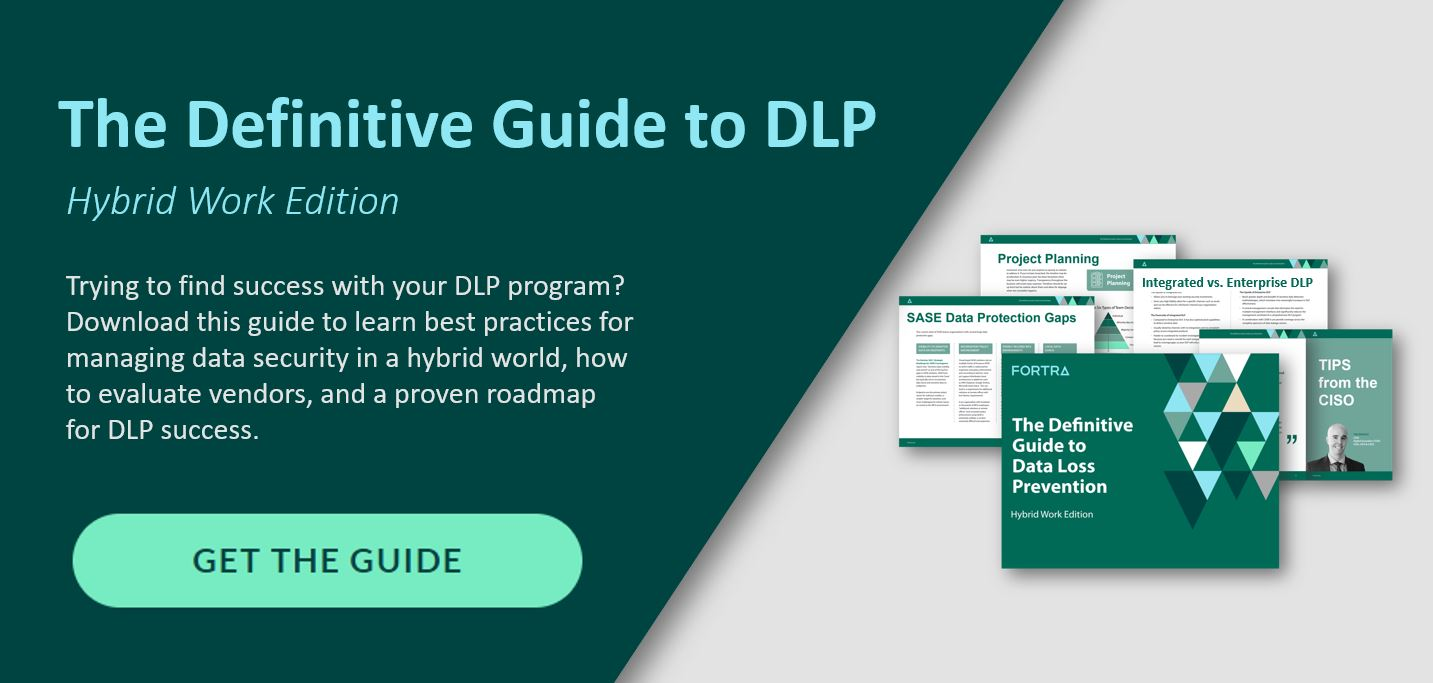When it comes to cybersecurity, there’s a multitude of solutions and similar terms. Even if you’ve been in this industry for a little while, you know that sometimes it can get confusing quick. That’s why we’re going to make this blog as clear as possible by reviewing the key differences between Integrated DLP and Enterprise DLP to give you the crucial information you need to select the right solution for your organization.
Part of the confusion over the difference between Integrated and Enterprise DLP comes as a result of an uptick in vendors offering some form of a DLP solution. This is because so many security companies these days are recognizing the importance of DLP in order to address the challenges of today’s cybersecurity landscape.
When a vendor embeds a feature or functionality to address a specific channel of data loss, this is usually referred to as Integrated DLP. For example, many secure email gateway providers these days have an added functionality that protects against leaks of data via email. Enterprise DLP on the other hand, is an integrated technology that protects against data loss from all channels and offers more robust capabilities.
In a recent report, "How to Choose Between Enterprise DLP and Integrated DLP Approaches,” Gartner defines Enterprise DLP as “products [that] offer centralized policy management and reporting functionality to define, disseminate and monitor DLP policies across one or more use cases, such as endpoint, network, discovery and cloud.”
There are advantages and disadvantages to both Integrated and Enterprise DLP. The right choice depends on the nature of your company’s data and risk tolerance.
Implementing an Integrated DLP solution has its benefits; it allows you to leverage existing investments, can give you high fidelity alerts for a specific channel, such as email, and can be effective for whichever channel your organization selects.
The downside of Integrated DLP, compared to Enterprise DLP, is that it usually has less sophisticated capabilities to detect sensitive data, can be siloed with no integration and often has no consistent policy across integrated products. It’s also often harder to coordinate for incident investigation and response because you need a console for each integrated product. This can lead to coverage gaps as your DLP will only cover specific egress vectors.
Considering those factors, Integrated DLP might be the right choice if your organization doesn’t have to worry about data privacy regulations or doesn’t have any high value intellectual property to protect.
After reading about the potential headaches with Integrated DLP, you might assume that Enterprise is the clear choice for your business, but we’d be remiss if we didn’t acknowledge some of the challenges with Enterprise DLP.
From a deployment standpoint, Enterprise DLP can be much more resource intensive and can add complexity to your program management. Still, though adding a solution like this can be a heavier lift for some, for organizations with privacy and data security compliance requirements or critical IP to protect, Enterprise DLP is worth the investment.
Some of the benefits include the ability to detect and classify sensitive data across your business, something that can enable organizations to gain full enterprise data visibility. This can lead to insights that will drive change in business processes and reduce risks.
Over time, this can create a more efficient workflow for your incident response team and simplify processes companywide with fewer consoles. In addition, if you couple your program with a cloud access security broker (CASB) or cloud DLP, your organization will be able to cover all egress vectors. Though Enterprise DLP may be more resource intensive, it provides the level of data protection that regulated, IP-intensive organizations need today.
To conclude, here’s an easy way to think about the difference between Integrated and Enterprise DLP. Imagine that every Sunday, you go to a great cafe to get your coffee. Afterward, you swing by your favorite fruit stand to buy some bananas before you go home. That’s your routine.
Now, imagine a report comes out from a reputable entity saying that everyone ought to have coffee every day as the American public is dangerously undercaffeinated. In response, the fruit stand announces that they’ve integrated coffee into their usual offerings. In this example, this is Integrated DLP. It holds appeal, as now we can get both our banana and coffee at the same place, which will save us time and potentially money.
The question we need to be asking ourselves is whether the coffee is any good. It’s very much within reason to assume our beloved fruit stand lacks the expertise and experience to deliver effective coffee. Meanwhile, our preferred cafe has years of experience making and delivering great coffee. In our extended metaphor, they are our Enterprise DLP.
While it may be more work and cost a bit more, we know our cafe will continue to deliver the excellent coffee we need to continue to function effectively.

Want to see Digital Guardian in action?
Learn how we can help your organization meet compliance, protect valuable IP and help reduce data loss.

